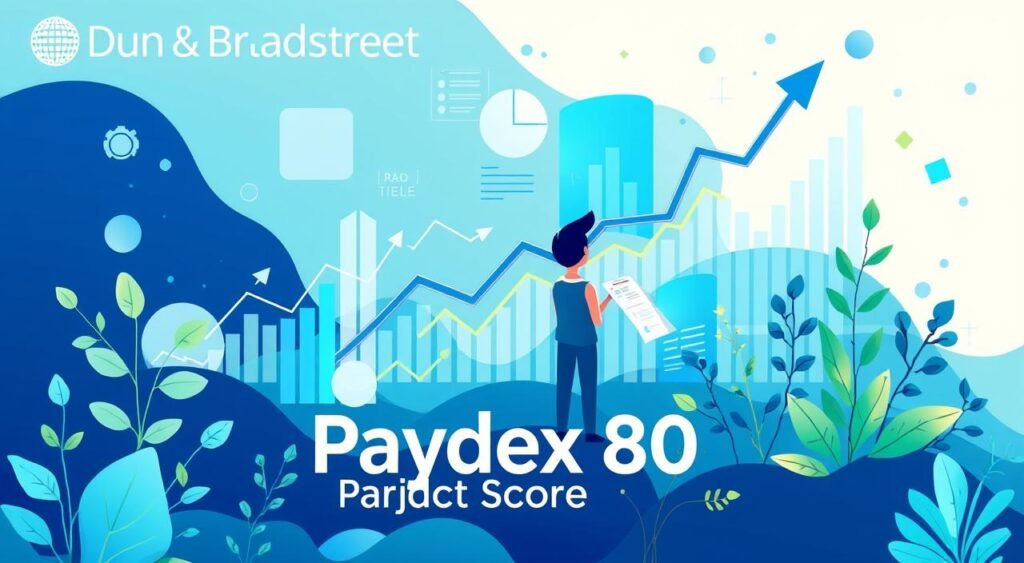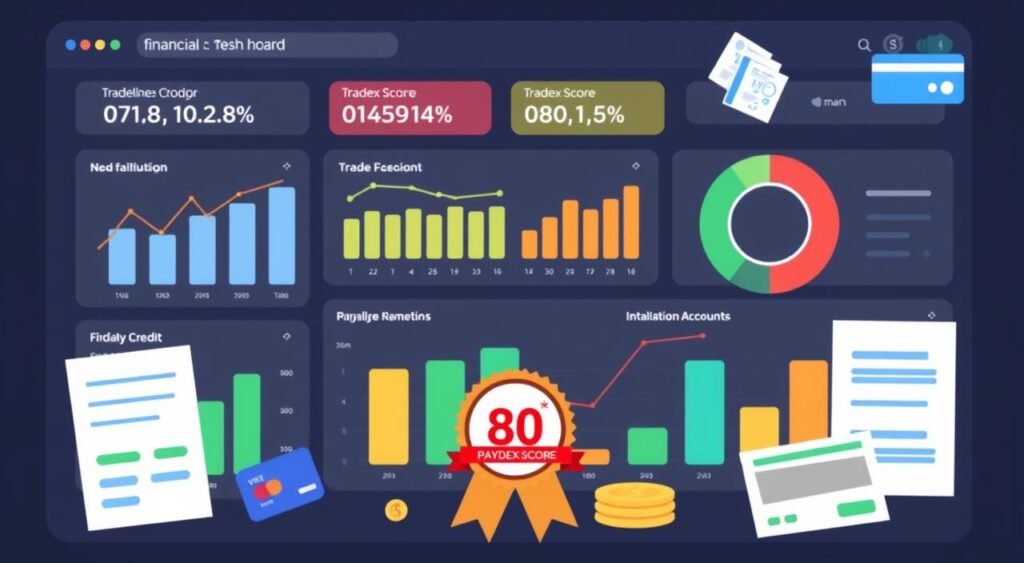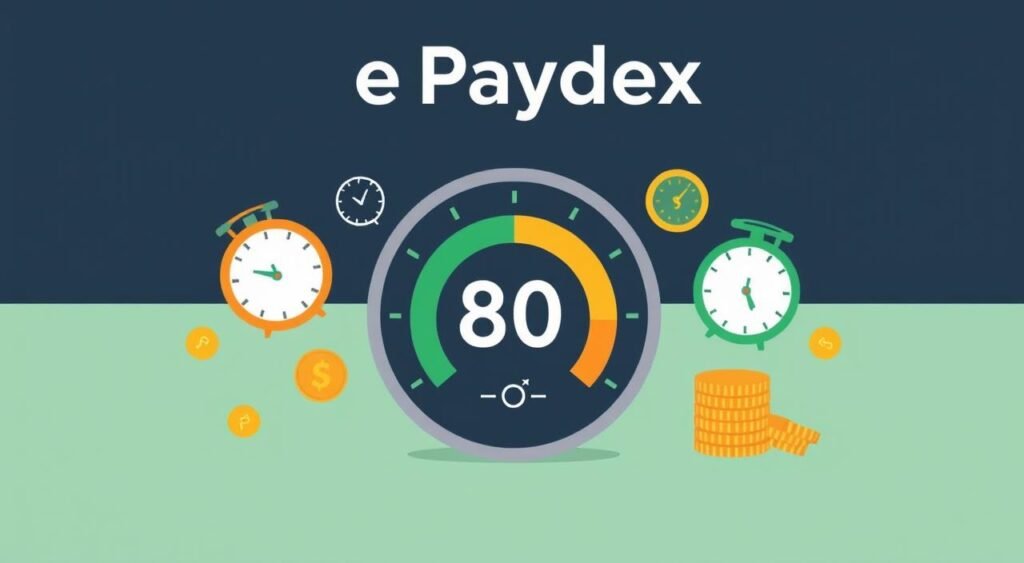Did you know a Dun & Bradstreet PAYDEX score of 100 means your business pays suppliers 30 days early1? This score can help you get better financing, trade terms, and supplier relationships. But, if your score is lower than 75, don’t worry. This article will show you 5 easy steps to quickly improve your PAYDEX score.
Key Takeaways
- A PAYDEX score of 75 or higher shows low risk for lenders and suppliers1
- Making payments early to vendors is key to a better PAYDEX score1
- Keeping low credit utilization can help boost your PAYDEX score, even though it doesn’t directly impact the score2
- Disputing errors on your Dun & Bradstreet report is crucial for an accurate PAYDEX score2
- Creating new tradelines with suppliers that report to D&B can quickly improve your PAYDEX score
Understanding the Paydex Score
What Is the Paydex Score?
The Paydex score is a business credit score from Dun & Bradstreet (D&B). It looks at how well a business pays its bills. Scores range from 1 to 100, with 100 being perfect3. It helps lenders and suppliers decide if they should trust a business with money3.
To get a Paydex score, D&B needs at least three payment records from two suppliers3. The score is based on how well a business pays its bills. Big payments count more than small ones4.
A score of 80 means a business pays its bills right on time, on average3. Scores above 80 mean they pay early. Scores below 80 mean they pay late3. Businesses should aim for a score of 80 or higher to show they’re reliable with payments3.
It’s important to report payments to D&B to improve the score. Also, paying bills on time helps a lot3. A good Paydex score can lead to better deals from lenders and suppliers. This can help a business grow and stay stable financially5.
| Paydex Score Range | Risk Level | Payment Timing |
|---|---|---|
| 80-100 | Low Risk | 0-30 days before due date |
| 50-79 | Medium Risk | 2-30 days late |
| 0-49 | High Risk | 31-120 days late |
Work with Creditors That Report to Dun & Bradstreet
To improve your Paydex score, find credit issuers that report to Dun & Bradstreet (D&B). Only accounts from these creditors help your Paydex score6. Start with vendor tradelines, as they are easier to get without much business credit history6. Financial tradelines from lenders need at least two years of business history and a good credit score.
According to Federal Reserve data, 43% of small businesses have sought financing at some point, with 58% seeking funds for operating expenses and 38% for expansion purposes.6 Business credit card companies report a wide range of information to credit bureaus like D&B, including purchases, payment history, business details, credit history, debt status, applications, and collections6. These reports are updated at the end of each billing cycle, which can vary from 28 to 31 days6.
Not all business credit cards report to Dun & Bradstreet, Equifax, Experian, or other credit agencies, and may only report negative information6. However, D&B is frequently used by business lenders for credit reporting, with some also using Experian, Equifax, or other agency scores6. A good business credit score increases the likelihood of qualifying for loans and securing favorable terms in the future6.
A wide range of credit card providers report to Dun & Bradstreet, such as Ramp, Tillful, Capital One, Bank of America, U.S. Bank, Corpay One, American Express, Chase, Citi, and Wells Fargo6. Some specific business credit cards that report to D&B include the Ramp Corporate Card, Nav Secured Card, Capital One Spark 1.5% Cash Back Business Credit Card, Capital One Spark Miles for Business, Bank of America Business Advantage Customized Cash Rewards Credit Card, U.S. Bank Business Platinum Card, U.S. Bank Business Leverage Visa Signature Card, and Corpay One Mastercard6.
Dun & Bradstreet determines business credit scores based on factors like payment history, business longevity, and credit utilization6. Additionally, a D-U-N-S number issued by D&B serves as a unique identifier for businesses, similar to a Social Security number for individuals6.
Beyond credit card providers, other vendors and suppliers, such as Creative Analytics, Shirtsy, and Quill, also report to Dun & Bradstreet, helping to build business credit and diversify credit sources6.

“Roughly two out of three net 30 vendors that report positive payment history opt to do so with Dun & Bradstreet.”7
To establish business credit with D&B, start with net 30 vendors that report exclusively to Dun & Bradstreet, such as Quill, Grainger, Uline, Gempler’s, and Namynot7. For quick tradeline building, net 30 companies like Nav Business Boost, Crown Office Supplies, Shirtsy, and Sparks Classic are good options, ensuring four tradelines reporting to D&B, Experian, and Equifax7.
Businesses aiming to improve their Paydex scores may find that many tier 2 credit sources require a score of 80 or higher from Dun & Bradstreet7. Additionally, Equifax and Experian are crucial bureaus for expanding business credit, especially when applying for fleet gas cards, business credit cards, and bank loans7.
An ‘Issue of Importance’ report profiles vendors like Ohana Office Products, Shirtsy, and Office Garner, all of which report to at least three major business credit bureaus7. Companies that report to Creditsafe, such as Maverick Office Supplies, usually include Experian reporting, offering the advantage of sharing payment data with various other smaller credit reporting agencies7.
Office Garner is recommended for businesses seeking to establish Ansonia business credit report tradelines, as it also reports to D&B and Equifax7. Opus Virtual Office and Moody’s Analytics (formerly Cortera) are valuable suppliers for building business credit, offering further reporting details such as reporting addresses, answering services, and additional bureaus like Equifax and Ansonia7.
For businesses interested in reporting to the Small Business Financial Exchange (SBFE), suppliers worth considering are Office Garner and Shirtsy, with additional reporting by the Divvy corporate card7.
In summary, working with creditors that report to Dun & Bradstreet is a crucial first step in boosting your Paydex score. By focusing on vendor tradelines, financial tradelines, and diversifying your credit sources, you can build a strong business credit profile and position your company for future success6.
Open New Tradelines and Credit Accounts
Now that you have a list of credit issuers that report to Dun & Bradstreet (D&B), it’s time to apply for new Business Credit Accounts and Trade Credit Accounts. Look for vendors like Uline, Quill, Grainger, and others that offer products or services you need. These vendors often have easy-approval net-30 accounts to help you build your Business Credit8.
After you’ve built a good payment history with three to six vendor tradelines, you can apply for Business Credit Cards and Business Loans that report to D&B. Vendors like Quill can approve or decline your credit in 24 hours. They require a $100 minimum order for a net 30 account credit application8. Some vendors, like Summa Office Supplies, don’t ask for personal guarantees for new customers and report to Equifax Business and Experian Business8.
| Vendor Tradeline | Credit Reporting | Application Requirements |
|---|---|---|
| Uline | Experian, Dun & Bradstreet | Use customer number from Uline catalog |
| Quill | Dun & Bradstreet | $100 minimum order, 24-hour approval |
| Summa Office Supplies | Equifax, Experian | No personal guarantee for tier 1 customers |
Remember, having a good payment history with these Tradelines is key to building your Business Credit and improving your Paydex Score9. By paying on time, you can aim for a Paydex Score of 80 or higher, which is excellent9.

“Establishing credit with tier 1 vendors offering credit payment terms and reporting positive payment history to business credit bureaus is a key step in building business credit.”
Make Timely or Early Payments
The Paydex Scoring System is key for businesses. It shows how well they pay their bills. Dun & Bradstreet uses it to rate companies from 0 to 10010.
A score of 80 or higher means you pay on time and are considered low-risk10. Scores between 50 and 79 show medium risk. Anything below 50 means you’re at high risk10.
Understanding the Paydex Scoring System
Dun & Bradstreet looks at your Payment History and Payment Timeliness to score you11. They focus on when you pay your bills11. To get a better score, pay your bills on time or early11.
Making Early Payments can quickly boost your score11. It shows you’re financially responsible. But, late payments can hurt your score and credit11.
| Paydex Score Range | Risk Level | Payment Behavior |
|---|---|---|
| 80-100 | Low Risk | Prompt Payments |
| 50-79 | Medium Risk | Moderate Delays |
| 0-49 | High Risk | Frequent Late Payments |
The Paydex Score is very important for businesses. It affects your financing, credit terms, and business relationships1011. By paying on time or early, you can improve your score. This shows you’re reliable to others1011.

Maintain Low Credit Utilization
Keeping your business credit utilization low is a smart move for managing your finances. It helps keep your Paydex score healthy12. High credit utilization can signal financial trouble to lenders13. It’s best to keep your debt low, so you can pay on time every month12.
Experts say to keep your credit utilization under 30%13. This means your outstanding balances should not be more than 30% of your total credit. Doing this shows you manage your debt well, which can boost your Paydex score and creditworthiness13.
To improve your credit, set up automatic bill payments. This keeps your payments on time and avoids late fees13. Also, check your credit reports from Experian, Equifax, and Dun & Bradstreet regularly. This helps spot and fix any errors that might harm your credit13.
While credit utilization doesn’t directly affect your Paydex score, it’s key to your business credit health. By managing your debt wisely, you can improve your financial standing and help your business grow12.
By keeping your credit utilization low, you show you’re financially stable and manage your debt well. This positively affects your Paydex score and overall creditworthiness1213.
Quick Paydex Score Improvement
If you want to quickly improve your Paydex score, focus on making payments on time. The Dun & Bradstreet PAYDEX Score ranges from 1 to 100. Higher scores mean better payment history14. Also, having at least three tradelines that report to D&B is key to getting a Paydex score for your business1.
To boost your Paydex score, open new credit accounts with vendors and lenders that report to Dun & Bradstreet. This builds your credit history and shows you pay on time1. Keeping your credit utilization low is also important. It shows you can handle your credit well.
By using these Quick Paydex Score Improvement strategies, you can quickly raise your Paydex score. A good Paydex score, like 75 or higher, can open doors to better financing and vendor relationships for your business1.
| Paydex Score Range | Risk Assessment |
|---|---|
| 80-100 | Low risk, timely repayments |
| 75-79 | Moderate risk, may indicate late payments |
| 40-74 | High risk, likely late payments |
| 0-39 | Very high risk, poor payment history |
Reporting payments to Dun & Bradstreet can improve your Paydex score. D&B offers packages to help businesses improve their scores by submitting payment information3.
“Maintaining a strong Paydex score is crucial for business success, as it directly influences your ability to secure financing, build vendor relationships, and enhance your overall credibility in the market.”
By using these Quick Paydex Score Improvement strategies, you can quickly improve your business credit. This opens up new opportunities for growth and success1413.
Dispute Inaccurate Information
Errors in your business credit report can hurt your Paydex Score. To fix this, you can challenge any wrong info in your D&B business credit report15.
Correcting Errors on Your D&B Report
Start by proving you’re who you say you are and that you own the business. Then, ask for updates through the D&B DUNS Manager portal or with the CreditBuilder service15. The Fair Credit Reporting Act says agencies must check into disputes within 30 days15.
It’s smart to check your business credit report often for mistakes16. Keeping your report right helps your Paydex Score show your real creditworthiness and payment history16.
Keeping your business credit report accurate is key for a good Paydex Score. By acting fast to correct any wrong info, you protect your business’s credit. This makes sure your credit profile really shows your financial health1516.
Tips for New Businesses
Starting a new business means building a solid credit foundation. First, get a DUNS Number17 and an Employer Identification Number (EIN)17. These numbers help keep your business finances separate from your personal ones. This is key for building business credit17.
Then, open vendor tradelines and pay on time. Data shows 3 out of 5 small businesses use business credit cards17. Half of them clear their balances monthly17. This responsible use boosts your Paydex Score, which vendors check to see if you’re creditworthy17.
Keep your business and personal credit separate. While 46% of small businesses use personal credit cards17, it’s wise to avoid mixing them. A strong business credit profile opens more financing options, gets you better credit terms, and shows your company’s trustworthiness. It also keeps your personal finances safe from business debts17.
By following these steps, new businesses can set a strong financial base. With a DUNS Number, EIN, and smart management of vendor relationships and payments, you’re on the path to a robust business credit profile17.
Conclusion
By following the five easy steps in this article, you can quickly boost your1819 Paydex score. This will improve your overall business credit profile. Key strategies include working with creditors, opening new tradelines, and making timely payments.
Keeping your credit utilization low and disputing any wrong information are also important. These steps can greatly enhance your Paydex score181920.
Using these proven methods can lead to better financing terms and payment conditions with suppliers. It also helps reduce financial risks for your business1820. A high Paydex score shows your company’s financial responsibility and creditworthiness.
This opens doors to new opportunities and strengthens your business credit management181920.
Remember, making consistent, on-time payments and regularly checking your business credit reports are crucial. This helps keep your Paydex score strong1820. By focusing on Paydex Score Improvement, Business Credit Management, Commercial Credit Building, and Financial Risk Mitigation, you can set your business up for success and stability181920.
FAQ
What is the Paydex score?
Why is having a high Paydex score important?
How do I identify credit issuers that report to Dun & Bradstreet?
What steps can I take to quickly improve my Paydex score?
How can I dispute inaccurate information on my D&B business credit report?
What steps should new business owners take to establish their business credit profile?
Source Links
- PAYDEX Score: The Dun & Bradstreet Business Credit Rating – https://www.nav.com/business-credit-scores/dun-bradstreet-paydex/
- How to Get an 80 PAYDEX Score | eCredable – https://business.ecredable.com/resources/blog/how-to-get-80-paydex-score
- PAYDEX Score: The Only Ultimate Guide You Need To Read – https://www.forbes.com/advisor/credit-score/paydex-score/
- What Is A Paydex Score? | Bankrate – https://www.bankrate.com/credit-cards/business/what-is-paydex-score/
- Understanding the Paydex Score – https://www.businessinsider.com/personal-finance/credit-score/what-is-paydex-score
- Best Business Credit Cards That Report to D&B in 2024 – https://ramp.com/blog/business-credit-cards-that-report-to-dun-and-bradstreet
- Net 30 Vendors That Report to DNB, Experian, Equifax & More – https://planning.net/business/credit/vendors/reporting/
- 7 Best Vendors To Help Build Business Credit in 2024 – https://tipalti.com/financial-operations-hub/vendors-that-report-business-credit/
- Business Tradelines That Build Your Business Credit – Credit Strong – https://www.creditstrong.com/business-tradelines/
- How to Get a PAYDEX Score of 80: The Essential Guide – https://www.unitedcapitalsource.com/blog/paydex-score-80/
- Paydex Score: Everything You Need to Know – https://paymentcloudinc.com/blog/paydex-score/
- How To Improve Your Business Credit Score – Tillful – https://www.tillful.com/resources/how-to-improve-your-business-credit-score/
- Maintaining a Great Business Credit Profile | Nav – https://www.nav.com/credit-building/how-to-maintain-good-business-credit/
- PAYDEX Business Credit Score: See What Yours Means – https://www.creditsuite.com/blog/decoding-the-paydex-business-credit-score/?srsltid=AfmBOophjjNxsPgsa4I_3sxPa-HJWc3AR1V_mi-Rwz17VkoC3QbYNmKT
- 3 ways to repair your business credit – https://www.linkedin.com/pulse/3-ways-repair-your-business-credit-crandall-business-credit-expert
- Understanding the PAYDEX Score: Your Business’s Credit Score 📊🏢 – https://www.linkedin.com/pulse/understanding-paydex-score-your-businesss-credit-paul-a-damiano-l3t4e
- How to Establish & Improve Your Business Credit Score – https://www.hud.gov/sites/dfiles/SDB/documents/Business Credit-How to Establish Improve Your Business Credit.pdf
- Paydex Scores: Your Key to Small Business Financial Success. – https://www.paycron.com/blog/unlocking-financial-success-a-comprehensive-guide-to-paydex-scores-for-small-businesses
- PAYDEX Score: The Dun & Bradstreet Business Credit Rating – https://ramp.com/blog/what-is-a-paydex-score
- The Essential Guide to Understanding What is a Paydex Score and Net 30 Vendors – https://theceocreative.com/the-essential-guide-to-paydex-scores-and-net-30-vendors/

